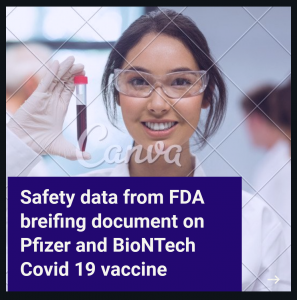FDA has released breifing document on Pfizer and BioNTech Covid 19 vaccine emergency use authorization.
Safety data key points from the document are:
- Efficacy overall (that’s the 95% you keep hearing about) and stratified by age group. Looks similar whether > or < 55 years of age.
- 126 serious events in vaccine group, 101 in placebo group.
- The most common solicited adverse reactions were injection site reactions (84.1%), fatigue (62.9%), headache (55.1%), muscle pain (38.3%), chills (31.9%), joint pain (23.6%), fever (14.2%)
- Severe adverse reactions occurred in 0.0% to 4.6% of participants, were more frequent after Dose 2 than after Dose 1, and were generally less frequent in participants ≥55 years of age (≤ 2.8%) as compared to younger participants (≤4.6%). The frequency of serious adverse events was low (<0.5%), without meaningful imbalances between study arms.
- Among non serious unsolicited adverse events – ie events the participants brought up on their own. Take home is to expect injection site reactions, fatigue, fever, chills, muscle pain – but most patients not bad enough to bother telling study coordinators about it. Reports of lymphadenopathy were imbalanced with notably more cases in the vaccine group (64) vs. the placebo group (6), which is plausibly related to vaccination. Bell’s palsy was reported by four vaccine participants and none in the placebo group. These cases occurred at 3, 9, 37, and 48 days after vaccination. One case (onset at 3 days post vaccination) was reported as resolved with sequelae within three days after onset, and the other three were reported as continuing or resolving as of the November 14, 2020 data cut-off with ongoing durations of 10, 15, and 21 days, respectively.
- Coming to serious adverse events, 6 deaths (4 placebo, 2 vaccine group). Vaccine group was one heart attack 62 days after vaccine and one death from “arteriosclerosis” 3 days after dose 1. All deaths represent events that occur in the general population of the age groups where they occurred, at a similar rate.
- The most common SAEs in the vaccine group which were numerically higher than in the placebo group were appendicitis (0.04%), acute myocardial infarction (0.02%), and cerebrovascular accident (0.02%), and in the placebo arm numerically higher than in the vaccine arm were pneumonia (0.03%), atrial fibrillation (0.02%), and syncope (0.02%).
- Appendicitis reported in 12 cases which needs further close monitoring during roll out.
- Three SAEs reported in the BNT162 group were considered by the investigator as related to vaccine or vaccine administration: shoulder injury, ventricular arrhythmia, and lymphadenopathy.
- Among participants 16 to 17 years of age, there was 1 participant in the vaccine group who experienced an SAE of facial bones fracture, which was not considered related to study intervention by the investigator.
- Two serious cases of suspected but unconfirmed COVID-19 were reported, both in the vaccine group.
- Among 3410 total cases of suspected but unconfirmed COVID-19 in the overall study population (~44000), 1594 occurred in the vaccine group vs. 1816 in the placebo group.
- Unsolicited AEs related to pregnancy include spontaneous abortion and retained products of conception, both in the placebo group. Pregnancy outcomes are otherwise unknown at this time.



Otherwise, there were no notable patterns or numerical imbalances between treatment groups for specific categories of non-serious adverse events (including other neurologic, neuro-inflammatory, and thrombotic events) that would suggest a causal relationship to BNT162b2 vaccine. With the exception of more frequent, generally mild to moderate reactogenicity in participants <55 years of age, the safety profile of BNT162b2 was generally similar across age groups, genders, ethnic and racial groups, participants with or without medical comorbidities, and participants with or without evidence of prior SARS-CoV-2 infection at enrollment.
Pharmacovigilance activities:
The Sponsor will conduct both passive and active surveillance activities for continued vaccine safety monitoring. Passive surveillance activities will include submitting spontaneous reports of the following events to the Vaccine Adverse Event Reporting System (VAERS) within 15 days:
- Vaccine administration errors whether or not associated with an adverse event
- Serious adverse events (irrespective of attribution to vaccination)
- Cases of Multisystem Inflammatory Syndrome in children and adults
- Cases of COVID-19 that result in hospitalization or death
The Sponsor will also conduct periodic aggregate review of safety data and submit periodic safety reports at monthly intervals. Each periodic safety report is required to contain descriptive information which includes:
- • A narrative summary and analysis of adverse events submitted during the reporting
- interval, including interval and cumulative counts by age groups, special populations
- (e.g., pregnant women), and adverse events of special interest
- • Newly identified safety concerns in the interval
- • Actions taken since the last report because of adverse experiences (e.g., changes made
- to Vaccination Provider fact sheets, changes made to studies or studies initiated)
Link for document:

Leave a Reply